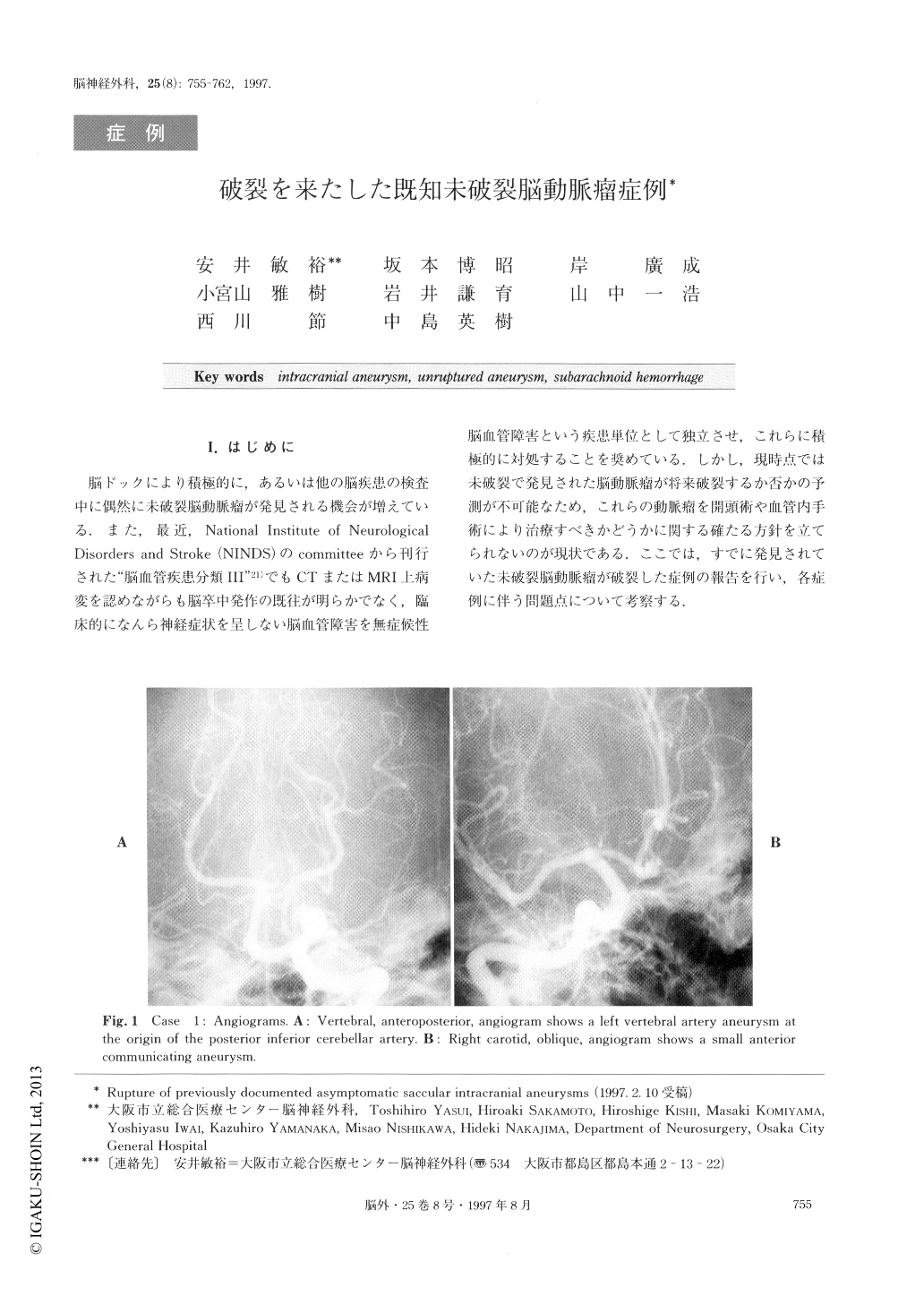Japanese
English
- 有料閲覧
- Abstract 文献概要
- 1ページ目 Look Inside
I.はじめに
脳ドックにより積極的に,あるいは他の脳疾患の検査中に偶然に未破裂脳動脈瘤が発見される機会が増えている.また,最近,National Institute of Neurological Disorders and Stroke(NINDS)のcommitteeから刊行された“脳血管疾患分類Ⅲ”21)でもCTまたはMRI上病変を認めながらも脳卒中発作の既往が明らかでなく,臨床的になんら神経症状を呈しない脳血管障害を無症候性脳血管障害という疾患単位として独立させ,これらに積極的に対処することを奨めている.しかし,現時点では未破裂で発見された脳動脈瘤が将来破裂するか否かの予測が不可能なため,これらの動脈瘤を開頭術や血管内手術により治療すべきかどうかに関する確たる方針を立てられないのが現状である.ここでは,すでに発見されていた未破裂脳動脈瘤が破裂した症例の報告を行い,各症例に伴う問題点について考察する.
The authors report four cases of patients with documented asymptomatic intact aneurysms that subse-quently ruptured. Case 1 involves a 64-year-old woman who had two unruptured aneuysms, i. e., an anterior communicating artery aneurysm and a posterior inferior cerebellar aneurysm, both were discovered during eva-luation of cerebral ischemic symptoms. At that time, only the posterior inferior cerebellar aneurysm was clipped. Seven years later, the patient bled fatally from a 5-mm untreated anterior communicating artery aneurysm that had measured approximately 3 mm on an angiogram obtained 7 years earlier. Case 2 is that of a 50-year-old woman who bled from an anterior com-municating artery aneurysm that had been discovered 6 years earlier when she suffered subarachnoid hemor-rhage (SAH) from a left middle cerebral artery aneu-rysm. At that time, she had refused surgery for the anterior communicating artery aneurysm. She reco-vered well from the second SAH. Case 3 is that of a 74-year-old woman who bled from a left paraclinoid in-ternal carotid artery aneurysm that had been disco-vered incidentally 3 years earlier during evaluation of vertigo. She had not agreed to have a clipping at that time the aneurysm was first discovered because of her age and the difficult location of the aneurysm. She eventually made an uneventful recovery. In the fourth case, during evaluation of cerebral ischemic symptoms, a 59-year-old man was discovered to have a large basi-lar bifurcation aneurysm. He underwent a craniotomy for clipping of the aneurysm. The aneurysm, however, was unclippable and was instead coated with Bemsheet. Four months later, the patient bled from the aneurysm and entered a vegetative state. The indications for sur-gery on unruptured asymptomatic cerebral aneurysms are still unclear. The cases reported herein show that asymptomatic aneurysms, especially anterior communi-cating aneurysms and aneurysms once exposed surgi-cally, do carry a certain risk for future hemorrhage and should not be dismissed as innocuous. Neurosurgeons have recognized the importance of considering life ex-pectancy in managing patients with asymptomatic, un-ruptured, intracranial aneurysms. With the rapid aging of the population, withholding aneurysm surgery mere-ly because a patient is elderly may not necessarily be the most appropriate decision.

Copyright © 1997, Igaku-Shoin Ltd. All rights reserved.


